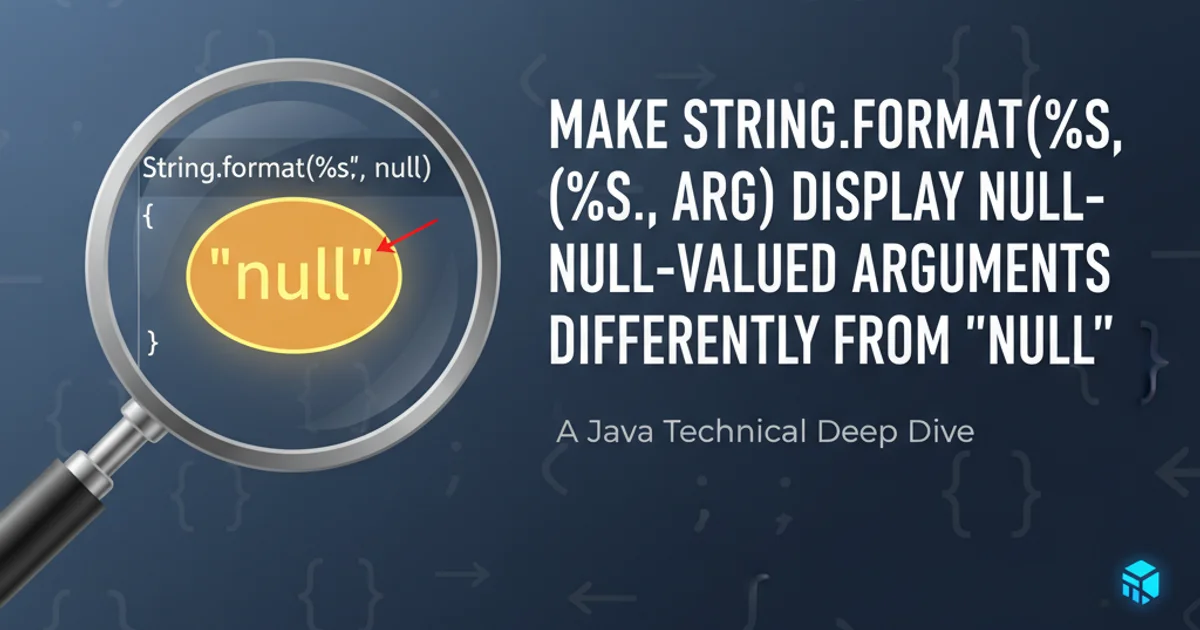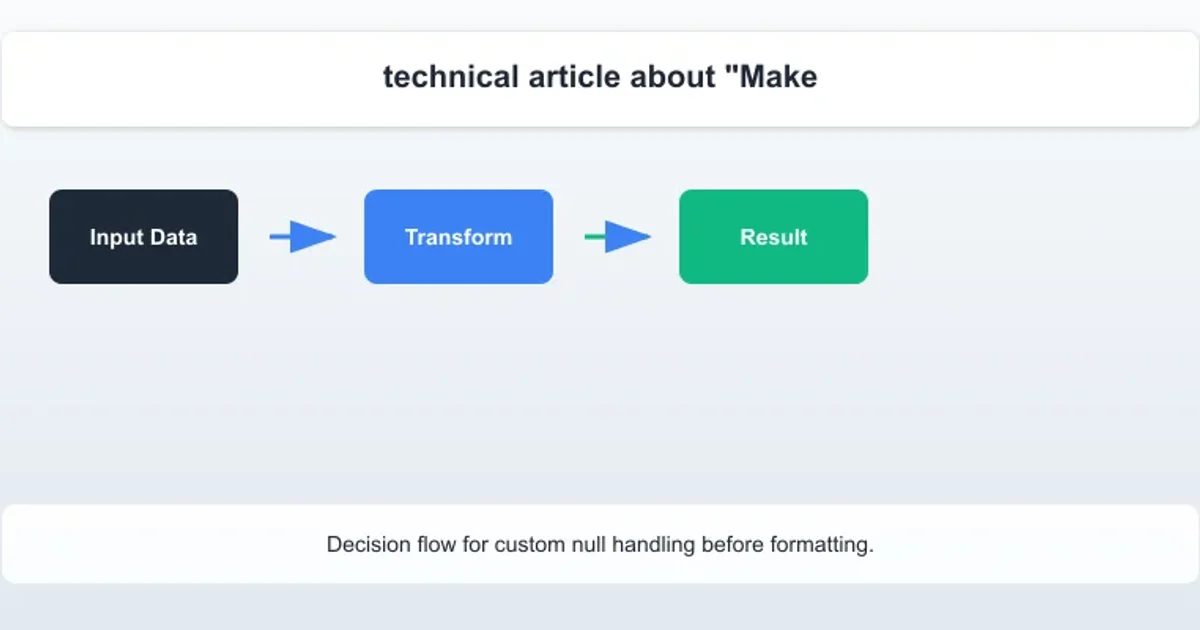Make String.format("%s", arg) display null-valued arguments differently from "null"
Categories:
Customizing Null Output in String.format() for Java

Learn how to prevent String.format("%s", null) from printing the literal string "null" and instead display a custom value or an empty string.
Java's String.format() method is a powerful tool for creating formatted strings, similar to C's printf. However, a common point of confusion arises when formatting null values using the %s specifier. By default, String.format("%s", null) will produce the literal string "null". While this behavior is well-defined, it's often not the desired output in user interfaces, logs, or data exports where an empty string, a dash, or a custom placeholder might be preferred.
Understanding the Default Behavior
The %s format specifier in String.format() is designed to convert any argument into its string representation. For non-null objects, this typically involves calling the object's toString() method. For null arguments, the Java Language Specification dictates that the result is the string "null". This consistency ensures predictable behavior but often requires developers to implement workarounds.
String nullValue = null;
String formattedString = String.format("The value is: %s", nullValue);
System.out.println(formattedString); // Output: The value is: null
String nonNullValue = "Hello";
String formattedNonNull = String.format("The value is: %s", nonNullValue);
System.out.println(formattedNonNull); // Output: The value is: Hello
Default behavior of String.format("%s", arg) with null and non-null values.
Strategies for Custom Null Handling
To achieve custom output for null arguments, you need to preprocess the argument before passing it to String.format(). There are several common approaches, each with its own advantages depending on the context and desired level of abstraction.

Decision flow for custom null handling before formatting.
Method 1: Ternary Operator (Inline Check)
The simplest and most common approach for a single argument is to use the ternary operator (? :) directly within the String.format() call. This allows you to substitute null with an empty string, a dash, or any other placeholder.
String name = null;
String age = "30";
// Replace null with an empty string
String output1 = String.format("Name: %s, Age: %s", (name != null ? name : ""), age);
System.out.println(output1); // Output: Name: , Age: 30
// Replace null with a dash
String output2 = String.format("Name: %s, Age: %s", (name != null ? name : "-"), age);
System.out.println(output2); // Output: Name: -, Age: 30
// Replace null with a custom placeholder
String output3 = String.format("Name: %s, Age: %s", (name != null ? name : "[N/A]"), age);
System.out.println(output3); // Output: Name: [N/A], Age: 30
Using the ternary operator for inline null replacement.
Method 2: Helper Method for Null-Safe String Conversion
For scenarios where you frequently need to convert potentially null objects to a custom string representation, a dedicated helper method improves readability and reduces code duplication. This method can encapsulate the null-checking logic.
public class StringUtil {
public static String nullToEmpty(Object obj) {
return obj == null ? "" : obj.toString();
}
public static String nullToDefault(Object obj, String defaultValue) {
return obj == null ? defaultValue : obj.toString();
}
public static void main(String[] args) {
String firstName = "John";
String lastName = null;
Integer score = 100;
Double average = null;
String output1 = String.format("Name: %s %s, Score: %s",
nullToEmpty(firstName),
nullToEmpty(lastName),
nullToEmpty(score));
System.out.println(output1); // Output: Name: John , Score: 100
String output2 = String.format("Avg: %s, Score: %s",
nullToDefault(average, "N/A"),
nullToDefault(score, "N/A"));
System.out.println(output2); // Output: Avg: N/A, Score: 100
}
}
Implementing helper methods for null-safe string conversion.
toString() method's behavior for custom objects. Ensure it provides a meaningful representation, or override it if necessary.Method 3: Using Objects.toString() (Java 7+)
Java 7 introduced java.util.Objects.toString(Object o, String nullDefault). This utility method directly addresses the need to provide a default string for null objects, making the code cleaner than a manual ternary operator or a custom helper for this specific use case.
import java.util.Objects;
public class ObjectsToStringExample {
public static void main(String[] args) {
String productCode = "P123";
String description = null;
Double price = 99.99;
Integer quantity = null;
// Using Objects.toString(Object o, String nullDefault)
String output1 = String.format("Code: %s, Desc: %s, Price: %s, Qty: %s",
Objects.toString(productCode, ""),
Objects.toString(description, "(No Description)"),
Objects.toString(price, "0.00"),
Objects.toString(quantity, "0"));
System.out.println(output1);
// Output: Code: P123, Desc: (No Description), Price: 99.99, Qty: 0
// For simply null to empty string, you can use Objects.toString(Object o)
// which defaults null to "null" (same as String.format) but is useful for consistency
String output2 = String.format("Code: %s, Desc: %s",
Objects.toString(productCode),
Objects.toString(description));
System.out.println(output2);
// Output: Code: P123, Desc: null
}
}
Leveraging Objects.toString() for null-safe string formatting.
Objects.toString(Object o, String nullDefault) is the most idiomatic way to handle null arguments for String.format() in modern Java when you need a specific default value.Choosing the Right Approach
The best method depends on your specific needs:
- Ternary Operator: Ideal for one-off or very few
nullchecks in a singleString.format()call where brevity is key. - Helper Method: Best for reusable logic across your application, especially if you have complex
nullhandling rules or need to apply the same default to many different types of objects. Objects.toString(Object o, String nullDefault): The recommended approach for modern Java (7+) when you need to replacenullwith a specific default string. It's concise, clear, and part of the standard library.
By proactively handling null values before they reach String.format(), you gain full control over your output, making your applications more user-friendly and robust.